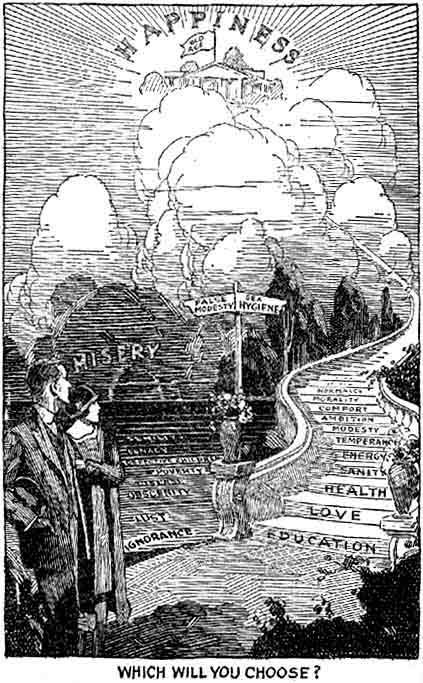Other sex-education books: Married
Love (1931), by Dr. Marie Stopes; Sex Facts for
Women (1936), by Richard J. Lambert; and see Miscellaneous
topics on this site
Marjorie May, three booklets, 1935 main page
 
|
 
THE MUSEUM OF MENSTRUATION AND WOMEN'S HEALTH: BIRTH CONTROL, MOTHERHOOD
Safe Counsel /or/ Practical Eugenics
by B. G. Jeffries, M.D., Ph.D., J. L. Nichols,
A.M., Ozora S. Davis, Ph.D., and Dr. Emma F. A. Drake (39th edition, 1928,
J. L. Nichols & Co., Naperville, Illinois, U.S.A.)
The first drawing in the book, below, shows that "sex hygiene"
- sex education - leads to happiness, whereas "false modesty"
doesn't.
This was not a new idea. For example, by this time, 1928, Margaret
Sanger, the founder of the American birth control movement (later
named Planned Parenthood by the pioneering advertising man Albert Lasker,
who devised much of the early Kotex ad campaign),
had already opened the first birth control clinic in America and written
newspaper columns on venereal disease (which were declared obscene and stopped).
(Incredibly, it wasn't until 1965 that a U. S. Supreme Court decision, Griswold
v. Connecticut, made birth control legal for American married couples, just
months before Sanger's death, at age 87.)
In the 1970s or early 1980s the American humor magazine National
Lampoon had a parody of a "good path, bad path" drawing
as its cover.
Below: see some of the volume's beautiful pen-and-ink drawings, typical
of the time.
SarahAnne Hazlewood generously donated the book to the museum.
|
 |
Words at left (darker than at right): ignorance,
lust, obscenity, disease, poverty, defective children, lunacy, senility
Words at right (light): education, love,
health, sanity, energy, temperance, modesty, ambition, comfort, morality,
normalcy [!]
Note that religion does not play a part,
in contrast to some earlier hygiene books (in Kellogg's Plain
Facts, for example.)
|
|




